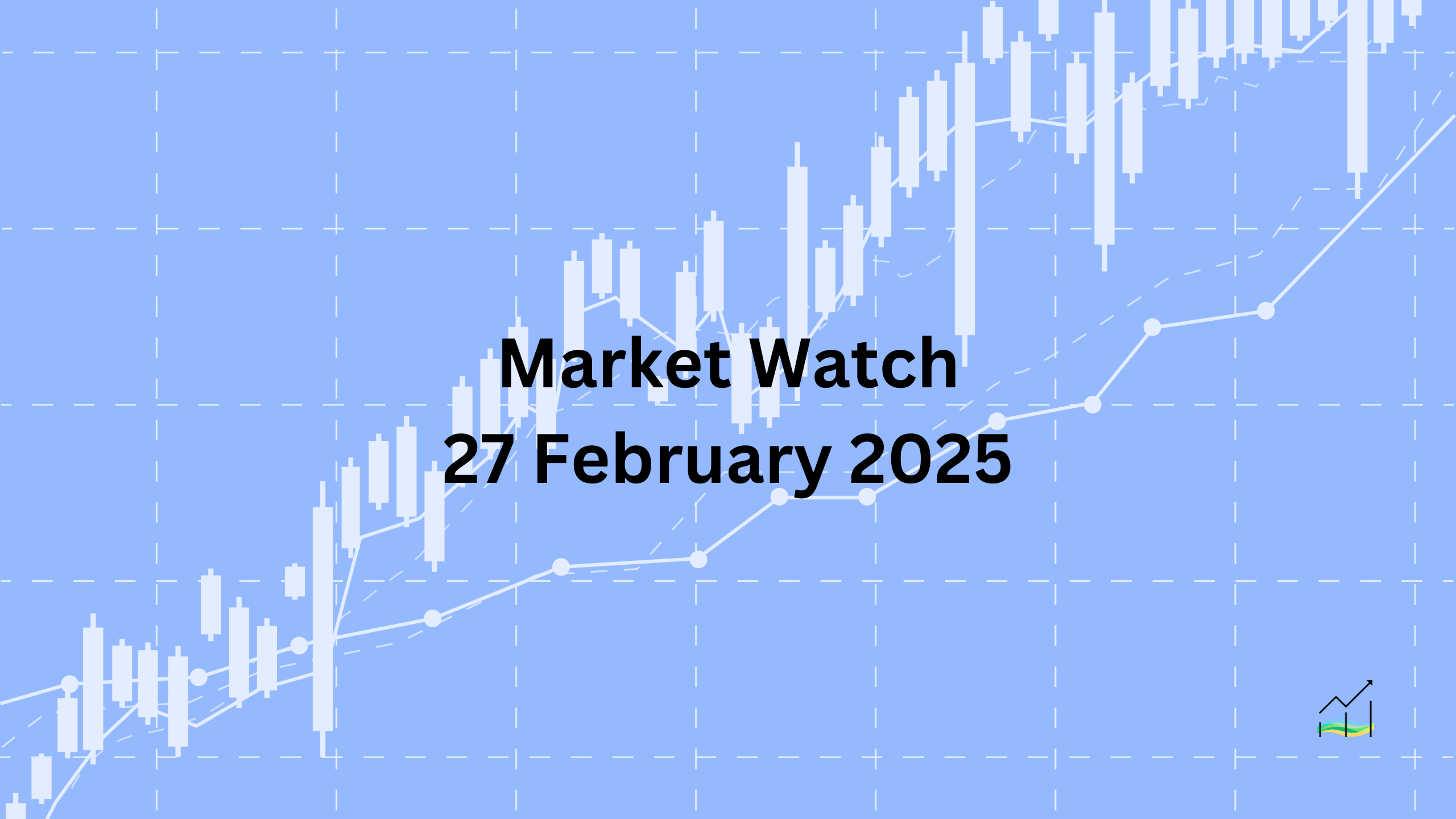27/02/2025 Market Watch

U.S. Rates Drop, Weighing on the Dollar
Concerns over economic growth triggered a sharp decline in US yields, a sell-off in equities, and a weaker US dollar. This was likely influenced by the Philadelphia Fed's non-manufacturing activity survey and the significant drop in consumer confidence reported by the Conference Board. While markets appear more stable today, the US dollar remains firm but mostly within yesterday’s trading ranges against G10 currencies, with mixed movements in emerging markets.
Adding to market uncertainties, the US government expanded its tariff considerations to include copper. This led to a strong rebound in May copper, which surged 5.2% from yesterday’s lows before settling near previous highs.
The US 10-year Treasury yield fell for a fifth consecutive session, briefly dipping below 4.30% for the first time this year. European benchmark yields are slightly lower, down by 2-4 basis points. Meanwhile, China’s plans to recapitalize major banks provided support to domestic and Hong Kong equities. The Hang Seng Mainland Index has gained 20.6% this year. Elsewhere in Asia, most major markets advanced, except for Japan and Australia. In Europe, the Stoxx 600 is up 0.80%, aiming for its largest gain in nearly two weeks. US futures are also showing strength following yesterday’s downturn.
Commodities saw notable moves as well. Gold declined by 1.25% but remains above $2900, holding support at its 20-day moving average, which it has stayed above since early January. Meanwhile, crude oil experienced a sharp drop, with April WTI falling 2.5% to its lowest level this year, just below $69. Today, it continues to hover around that key level.
United States of America
Overview
Falling US yields have kept the dollar under pressure despite renewed tariff threats. The two-year yield dropped to 4.07%, its lowest level since November 1, while the 10-year yield settled below 4.30%, a level not seen since December 12. The dollar remains in consolidation after weakening yesterday.
Economic Drivers
The decline in yields comes as markets continue to digest the higher-than-expected January CPI data from February 12. That day, the two-year yield peaked for the month at 4.38%, while the 10-year yield hit 4.66%. Since then, yields have steadily fallen, outweighing the impact of new trade policy concerns.
Meanwhile, former President Trump renewed tariff threats on Canada and Mexico, set to take effect next week. Despite this, the market reaction has been muted, with the Dollar Index testing resistance near 106.75 before falling slightly below 106.20 yesterday. It remains within a narrow range today, needing a breakout above yesterday’s high to signal a shift.
Data and Events
US housing data is in focus, with January new home sales, building starts, and permits set for release. Rising mortgage rates in January may have slowed home sales after a 3.6% gain in December. Housing starts surged by 16.1% in December—the largest increase since March 2021—but are expected to have slowed by nearly 10% in January.
Price Action
The Dollar Index briefly tested resistance but failed to hold gains, hovering near 106.20 and staying above Monday’s low of 106.10. A move above yesterday’s high is needed for any meaningful upside momentum.
Key Points:
- US two-year yield dropped to 4.07%, its lowest since November.
- US 10-year yield settled below 4.30%, down from its February peak of 4.66%.
- Trump’s tariff threats on Canada and Mexico had a limited market impact.
- The Dollar Index remains in consolidation, needing a breakout for direction.
- US housing data is expected to show a slowdown in January after strong December gains.
Australia
Overview
The Australian dollar has been unable to break key resistance and continues to decline. It stalled near $0.6410, just below the 38.2% retracement level of its decline from $0.6940 in late September to its early February low under $0.6090. The currency is now lower for the fourth straight session and has fallen in six of the past seven sessions. A break below $0.6320, which is already under pressure, could lead to further losses toward $0.6285 and possibly $0.6250.
Economic Drivers
Australia's inflation data showed little change, with January CPI holding at 3.4%, the same as December. The market had expected a slight increase, though the trimmed mean did rise. Inflation previously bottomed at 2.1% in September-October, indicating some persistence in price pressures. Despite this, the data has had little impact on expectations for the Reserve Bank of Australia’s (RBA) next rate cut.
Data and Events
Australia’s private sector credit data is due before the weekend. In December, it rose by 0.6%, slightly above last year’s average monthly increase. However, this is unlikely to shift RBA policy expectations. The futures market sees a 77% chance of a rate cut in May, with a full cut priced in for July and another expected by year-end.
Price Action
The Australian dollar remains under pressure, failing to hold gains near $0.6410. A firm break below $0.6320 would open the door for further downside, with key support levels at $0.6285 and $0.6250.
Key Points:
- The Australian dollar stalled below key resistance at $0.6410 and is falling for the fourth straight session.
- A break below $0.6320 could lead to further declines toward $0.6285 and $0.6250.
- January CPI remained at 3.4%, slightly below expectations, while the trimmed mean rose.
- Private sector credit growth was slightly above trend but has little impact on RBA rate cut expectations.
- Markets expect the RBA’s first rate cut in May, with another fully priced in by July and an additional cut by year-end.
Canada
Overview
The US dollar continues to strengthen against the Canadian dollar, reaching a nine-day high near CAD1.4320 yesterday and extending to CAD1.4340 in European trading. This marks the fourth consecutive session of gains and the seventh in the past eight. The move comes amid concerns over potential US tariffs on Canada and Mexico, with markets viewing it as a negotiation tactic rather than a direct threat to trade.
Economic Drivers
Tariff uncertainty remains a key factor influencing the market, with traders reacting to Trump’s statement that the proposed tariffs are still on track. While this could be part of broader trade negotiations, it has added to market volatility. Meanwhile, expectations for a Bank of Canada rate cut in March have increased, with the probability rising from 25% last week to nearly 50% now.
Data and Events
The US dollar recently broke above its 20-day moving average (around CAD1.4295) for the first time since February 3. It had previously touched a two-month low of CAD1.4150 on February 14. The 38.2% retracement level from the February 3 spike (around CAD1.48) is near CAD1.44, a key resistance level to watch.
Price Action
The US dollar’s climb above CAD1.4295 suggests renewed upside momentum. A move toward CAD1.44 could be possible if the current trend continues, while support remains near CAD1.4150.
Key Points:
- The US dollar is strengthening against CAD, reaching CAD1.4340 today.
- Markets remain cautious over potential US tariffs on Canada and Mexico.
- The US dollar has gained in four straight sessions and seven of the last eight.
- The probability of a Bank of Canada rate cut in March has risen to nearly 50%.
- Key resistance stands at CAD1.44, while support is near CAD1.4150.
China
Overview
The US dollar tested a two-week downtrend against the offshore yuan (CNH), reaching a three-day high slightly above CNH7.2700 yesterday before pulling back to around CNH7.2475. Earlier in the week, the greenback bottomed near CNH7.2260, its lowest level since November 19. The currency pair remains within yesterday’s range today. So far this year, the offshore yuan has gained approximately 1.1% against the US dollar, while the onshore yuan has risen by about 0.6%.
Economic Drivers
The People’s Bank of China (PBOC) set the dollar’s reference rate at CNY7.1732 today, slightly above yesterday’s CNY7.1726. This marks the highest fix since Trump's second inauguration on January 20. The central bank’s daily reference rate continues to play a role in managing currency movements.
Data and Events
China announced plans to inject at least CNY400 billion into three of its largest banks in the coming months. This recapitalization effort boosted Chinese bank stocks, reflecting optimism in the financial sector.
Price Action
The US dollar remains in a consolidation phase against the yuan, with CNH7.2700 acting as resistance and CNH7.2260 providing support. A break above the downtrend could see further upside, while continued pressure from the PBOC's reference rate adjustments may limit volatility.
Key Points:
- The US dollar tested a two-week downtrend, reaching CNH7.2700 before pulling back.
- Offshore yuan has appreciated 1.1% this year, while the onshore yuan is up 0.6%.
- The PBOC set the dollar’s reference rate at CNY7.1732, the highest since January 20.
- China plans to recapitalize three major banks with at least CNY400 billion.
- Key support at CNH7.2260, resistance near CNH7.2700.
Europe
Overview
The euro has been range-bound between $1.04 and $1.0530 over the past five sessions, with no significant breakout so far. The US-Germany two-year yield spread, which peaked near 225 basis points on February 10, has narrowed to around 200 basis points. The last time it was this low was in late January at 193 basis points. The euro’s January high was just under $1.0535.
Economic Drivers
The European Central Bank (ECB) is expected to ease policy again next week, with at least two more rate cuts priced into the market. This has softened the short end of the yield curve. On the longer end, anticipated bond issuance has kept German yields elevated, while French and Italian yields have shown mixed movements.
Data and Events
Germany’s CDU/CSU is negotiating with the SPD to pass a €200 billion defense budget before the new Bundestag convenes on March 24. This maneuver, previously used in 1998 during the Kosovo War, aims to secure funding before potential political shifts.
Price Action
With the ECB's dovish stance and shifting yield spreads, the euro remains stuck in a tight range. The key level to watch is $1.0535, as a break above could signal further upside, while support at $1.04 remains firm.
Key Points:
- The euro is trading between $1.04 and $1.0530, lacking direction.
- US-Germany two-year yield spread has narrowed from 225 bp to 200 bp.
- The ECB is expected to ease policy next week, with two more cuts priced in.
- Germany’s CDU/CSU is pushing for a €200 billion defense budget before March 24.
- German 10-year yields are up 8 bp this year, while French and Italian yields remain mixed.
Japan
Overview
The US dollar is struggling against the yen as the decline in the US 10-year yield weighs on the greenback. The US 10-year yield premium over Japan has fallen to around 290 basis points, its lowest level since October. This spread had bottomed near 275 basis points last September, while last month's peak of around 358 basis points was the highest since May 2024.
Economic Drivers
The narrowing yield spread between the US and Japan is a key factor pressuring the USD/JPY pair. A further decline in US yields could extend this trend, keeping the yen supported.
Data and Events
The economic calendar is light until Friday when key Japanese data will be released, including Tokyo’s February CPI, which is expected to moderate after January’s rise. Other reports include January’s industrial output, which is projected to be weak, and a likely rebound in retail sales after December’s 0.8% decline.
Price Action
The dollar reached JPY150.30 before dropping to JPY148.55, breaking below the December 2024 low. It is currently consolidating within yesterday’s range, but further downside risk remains, with support at JPY147, aligning with the 61.8% retracement of the dollar’s rally from September 2024 to January 2025.
Key Points:
- US dollar is under pressure as US 10-year yields decline.
- US-Japan yield spread has narrowed to 290 bp, its lowest since October.
- The next key support level is JPY147, aligning with the 61.8% retracement.
- Tokyo’s February CPI, industrial output, and retail sales data are due Friday.
United Kingdom
Overview
GBP/USD remains capped below $1.2680 despite holding above $1.2600. Last week’s low near $1.2565 remains a key level, as a break below it would signal a near-term top. Since mid-January, sterling has recovered about 4.9% after falling nearly 10% from September to January. The 50% retracement of this decline is around $1.2765, while the 200-day moving average sits near $1.2785.
Economic Drivers
Sterling’s recovery has been driven by technical factors rather than fundamental catalysts, as the economic calendar remains light. The pair faces resistance at $1.2680, with further upside dependent on broader market sentiment and economic data.
Data and Events
The UK’s economic calendar is quiet, with Nationwide’s house price index due on Friday. The year-over-year growth is expected to slow from January’s 4.1%. On the political front, Prime Minister Starmer is set to meet US President Trump, though little change is expected regarding US foreign policy on Ukraine or global alliances.
Price Action
Sterling has been trading in a tight range below $1.2680. A break above could see a test of $1.2765 (50% retracement) and $1.2785 (200-day moving average). Conversely, a move below $1.2565 would indicate a short-term top, opening the door for further declines.
Key Points:
- GBP/USD remains below $1.2680 resistance, with support at $1.2565.
- Sterling has rebounded 4.9% since mid-January after a 10% decline.
- Key levels to watch: $1.2765 (50% retracement) and $1.2785 (200-day MA).
- Nationwide’s house price index is due Friday, with slower growth expected.
- PM Starmer meets US President Trump, but policy shifts are unlikely.
© 2025 SKONE Enterprise (003319453-V). All rights reserved.
The content on this site is for informational purposes only and does not constitute financial advice.


